C-141B Starlifter
The Lockheed C-141 Starlifter is a multipurpose tactical and strategic airlift aircraft. It is designed to operate without any ground support equipment from remote airfields or unimproved surfaces. From the deserts of Africa to the Jungles of South America to the ice of Antarctica you'll find the Starlifter. The Starlifter can carry cargo, vehicles, passengers, paratroops, and combinations thereof. It's low stance and rear cargo doors allow cargo to be loaded and unloaded with just a forklift and the built in winch. It can also be rapidly loaded and unloaded using the K-Loader for palletized cargo. The cargo and troop doors can be opened inflight for airdrop of cargo and paratroops. The Starlifter can be found carrying troops, supplies, hurricane relief, and even the President's Limousines. |
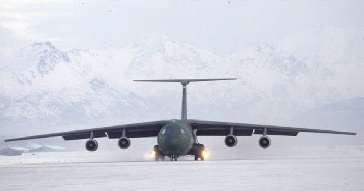 Starlifter in Alaska |
 Current Enlisted Aircrew Wings. |
Until recently, I was a Flight Engineer on the Starlifter. When people give me a "deer in the headlights" look it's usually that they don't know what a Flight Engineer is. I tell them I'm like Scotty or Geordie on the Enterprise in Star Trek. But I spend most of my time on the bridge. There's a saying that a pilot isn't paid to fly, he's paid for all the crap he has to put up with on the ground. Well my saying is that C-141 Flight Engineers aren't paid to fly, they're paid to preflight the aircraft. |
The first responsibility of a C-141 Flight Engineer is preflighting the aircraft. That's where the work is. The flying is the fun part. We also compute performance data. This includes takeoff and landing data, cruise data, airdrop data, and thousands of other performance figures such as what's the highest altitude can we cruise at. Of course, a computer could do these calculations for me. And my calculations are checked against a computer on board. What scares me about aircraft that do exclusively use a computer is how many times our on board computer has been wrong. (Under such circumstances I recheck my data twice, and so does the other Engineer.) But the most important aspect of the job is the Engineer is being the systems specialist. The Pilot/Aircraft Commander is the man in charge. The aircraft and the mission is his responsibility and his decision whether we go or not. The Engineer's responsibility is to explain to him why it's safe or unsafe and why. But where it really is important is when inflight malfunctions occur. A Flight Engineer must have the systems knowledge to know what corrective action the crew should take, how the malfunction will affect the safe operation of the aircraft, and the effect the possible solutions may have on the safe recovery of the aircraft. This frees the Aircraft Commander and Copilot to maintain control of the aircraft and interact with Air Traffic Control to prevent a minor malfunction from becoming a major disaster. When there are only two pilots on the aircraft, a second Engineer, acting as the Scanner for the aircraft, sits in the Jump seat. This provides a third pair of eyes for the pilots. |
|
 C-141B Starlifter 65-0272 McGuire AFB, NJ |
Here you can see the Starlifter's cockpit. At the right is my seat and panel. From here I can operate all aircraft systems, calculate performance data, and deal with malfunctions. On the left you see the navigator. With the instruments on his panel he can plot and monitor our course. The majority of the time the Pilots perform these duties. But during an Airdrop the accuracy required makes a Navigator a needed crew member. Plus there is so much to do during an airdrop. We can't fly airdrop without one. On the front left you can see the Pilot/Aircraft Commander. He's responsible for the crew and mission. He must be in the seat for all critical phases of flight including takeoff, landing, airdrop, and air refueling. |
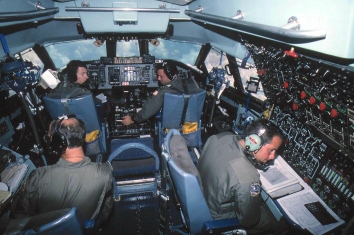 C-141B Starlifter Cockpit |
To the front right sits the Copilot. He assists the Pilot in flying the aircraft. During an emergency normally he flies the aircraft, backed up by the Pilot, while the Pilot and Flight Engineer deal with the problem. In the center you can see the empty Jump Seat. This position is filled by a third pilot or the other Flight Engineer, (called a Scanner when not sitting in the Flight Engineer's seat,) during critical phases of flight. Not pictured is the Loadmaster. He typically sits in the cargo compartment. The Loadmaster ensures the safe loading and unloading of the aircraft, calculates the weight and balance of the aircraft, takes care of passengers, configures the cargo compartment for the mission, and performs airdrops. Without him we can't do much. The only time we don't have a Loadmaster is on local training missions that don't carry cargo. On those flights the Flight Engineer filling the Scanner position performs any needed Loadmaster duties. |
|
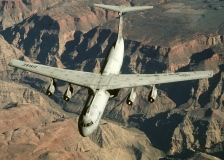 C-141B Starlifter over the Grand Canyon |
The Starlifter is affectionately called a "swept-wing, T-tailed bug-sucker" by those who fly her. This is because it's remarkable manuverability and climb capabilities make it an exceptional low level aircraft. When I received my airframe assignment I was just happy to get a jet. Since I've started flying I've found the C-141 is awesome. Designed by Lockheed in the 1950's, it's engines are much more powerful than a similarly sized aircraft from it's era. Add the high lift wing to the equation and you have an aircraft that leaps off the runway, and can even out-climb the F-4 Phantom II. The Lockheed designers are mechanical geniuses. While learning this aircraft I've found there are hundreds of components and systems that are amazing. Once you learn how they work you think, "Of course, there's no better way to do that." But then you think that you'd never have come up with that on your own. Any other company would install a computerized and/or powered component for ten times the cost and ten times the chance of failure. Lockheed engineers have figured out much simpler ways that work better anyway. |
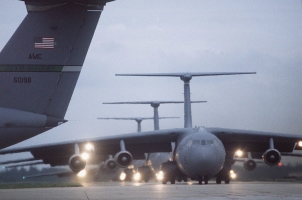
C-141B Starlifters ready for a formation takeoff |
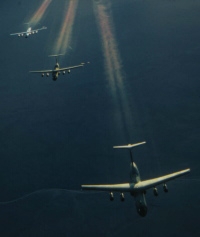 C-141B Starlifters in formation |
 C-141B Starlifter being loaded via a K-Loader |
Formation airdrop capability enables the United States to drop troops, equipment or relief supplies anywhere in the world without the need of a place to land, and do it in sufficient numbers for any purpose. There is no better aircraft in the world for this mission.
Here you can see a Starlifter being loaded by an Air Force Load Team assisted by a crew member. By using K-Loaders a Starlifter can quickly be unloaded and loaded allowing for short turnaround times. If only this had been available during the Berlin Airlift. The ramp can be lowered to the ground to load vehicles and other rolling stock. Inside the cargo compartment the Loadmaster in charge directs the operation to make sure the cargo is loaded correctly and safely. |